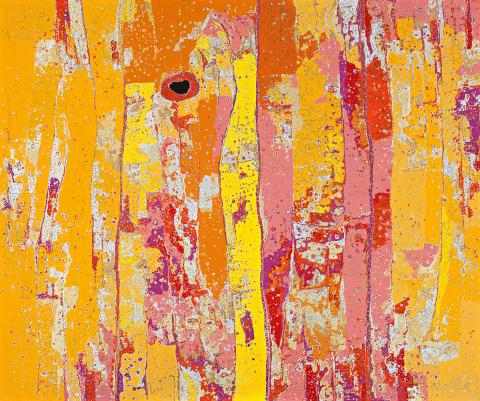KIRRIWIRRI, 2013
DANIEL WALBIDI
synthetic polymer paint on linen
171.0 x 205.0 cm
bears inscription verso: artist’s name, title, date, medium, size and Short Street Gallery cat. 825079
Short Street Gallery, Broome
The McKay Superannuation Fund Art Collection, Brisbane
Newstead, A., The Dealer is the Devil, Brandl and Schlesinger, Sydney, 2014, p. 47 (illus.)
This work is accompanied by a certificate from Short St. Gallery which states: ‘”Kirriwirri” is my grandfather’s and my grandmother’s country. That is where they brought up all their children, and where my father was brought up. It is like their family home, their roots. There is a big claypan at this place, it is an important place for our family. Our clan is also named Kirriwirri, and individual members of our clan are named Kirriwirri.
Kirriwirri is a Jila (living water) near well 33 on the canning stock route in the Great Sandy Desert. Daniels painting reflects the complex desert landscape full of life and colour. He depicts salt lakes (white areas) and the talis (sand hills). Kirriwirri is the birthplace of my father’s family it is the family home. My father along with his older siblings spent their childhood and adolescence here. Kirriwirri is also important to many other family and clan groups because it is a living jila meaning it has water that never dries out even during the driest of seasons. I have never been to Kirriwirri but I have a deep desire within to travel and see this country to become connected. My grandparents have sadly passed away a long time ago so I guess if I ever do go back to Kirriwirri I would be taking them back. I also paint another important place called Wirnpa. Wirnpa and Kirriwirri are very important to me because I am related to two of these jila. Kirriwirri is my grandfather and Wirnpa is may grandfather they also relate to each other being brothers in laws. Wirnpa is of the same skin group as me, we are both purungu and Kirriwirri is the milangka skin group.’
Daniel Walbidi is the inadvertent catalyst behind the emergence of a contemporary art movement of the Yulparija people based at Bidyadanga (formerly La Grange Mission), south of Broome on the Western Australian coast. As a sixteen year old, his visit in 1999 to the Short Street Gallery in Broome to exhibit some of his paintings led to the Gallery providing a group of elders with modern painting materials. These were embraced enthusiastically to depict the history and lands of the Yulparija, an inland desert group forced to migrate to the coast in the 1960s following a severe and prolonged drought. While most of the recognised Yulparija painters such as Weaver Jack, Alma Webou and Parlurn Harry Bullen were all senior cultural leaders, Walbidi emerged as a leading light among the younger generation. His rise to prominence began with a solo exhibition at William Mora Galleries in 2006; in 2008, he was selected for the Xstrata Emerging Indigenous Art Award and in 2009, for the Western Australian Indigenous Art Awards; in 2012, he was represented in unDisclosed, the 2nd National Indigenous Art Triennial at the National Gallery of Australia; and in 2013, he was a finalist in the prestigious Wynne Prize at the Art Gallery of New South Wales.
Kirriwirri has a profound personal connection for the artist; it is Walbidi’s paternal grandparents’ country, where his father was born and raised. Kirriwirri also lies near Kunawarritji, Well 33 on the Canning Stock Route, nearby the birthplace of Rover Thomas. The site features a large claypan and salt lakes (the white areas in the painting), living jila (permanent freshwater springs) and tali or sandhills. Accordingly, this chromatically scintillating painting may be considered as a yearning to visit Kirriwirri, which at the time it was created, Walbidi had not done. The work reflects the subject of much Yulparija art, the depiction of now distant lands that were once inhabited and remain ‘home’. This approach to art is reminiscent of that of the very first painters at Papunya in 1971 who were inspired by the ancestral lands from which they had been removed.
WALLY CARUANA
